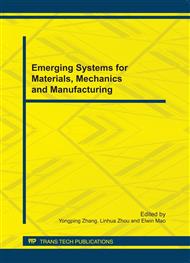[1]
A. C. Hoffmann and L. E. Stein: Gas Cyclones and Swirl Tubes: Principles, Design and Operation. New York (2007), Springer.
Google Scholar
[2]
S. Movafaghian, J.A. Jaua-Marturet, R.S. Mohan et al: The effects of geometry, fluid properties and pressure on the hydrodynamics of gas-liquid cylindrical cyclone separators. International Journal of Multiphase Flow Vol. 26 (2000), pp.999-1018.
DOI: 10.1016/s0301-9322(99)00076-2
Google Scholar
[3]
I. Arpandi, A.R. Joshi, O. Shoham et al: Hydrodynamics of two-phase flow in gas-liquid cylindrical cyclone separators. Soc of Petre Eng Vol. 1(4) (1996), pp.427-436.
DOI: 10.2118/30683-pa
Google Scholar
[4]
A. J. Hoekstra, J. J. Derksen and H.E.A. Van Den Akker: An experimental and numerical study of turbulent swirling flow in gas cyclones. Chemical Engineering Science Vol. 54(13) (1999), p.2055-(2065).
DOI: 10.1016/s0009-2509(98)00373-x
Google Scholar
[5]
J. J. Derksen: Separation performance predictions of a stairm and high-efficiency cyclone. AIChE Vol. 49(6), 2003, pp.359-1370.
Google Scholar
[6]
S. Murphy, R. Delfos, M.J.B.M. Pourquiéb et al: Prediction of strongly swirling flow within an axial hydrocyclone using two commercial CFD codes. Chemical Engineering Science Vol. 62(6) (2007), pp.1619-1635.
DOI: 10.1016/j.ces.2005.10.031
Google Scholar
[7]
J. Wang: Modelling of strongly swirling flows in a complex geometry using unstructured meshes. International Journal of Numerical Methods for Heat & Fluid Flow Vol. 16(8) (2006), pp.910-926.
DOI: 10.1108/09615530610702069
Google Scholar
[8]
B. Wang, K.W. Chu and A.B. Yu: Numerical study of particle fluid flow in a hydrocyclone. Ind Eng Chem Res Vol. 46(13) (2007), pp.4695-4705.
DOI: 10.1021/ie061625u
Google Scholar
[9]
J.C. Cullivan, R.A. Williams and C.R. Cross: Understanding the hydrocyclone separator through computational fluid dynamics. Trans IChemE Vol. 81 (2003), Part A, pp.455-466.
DOI: 10.1205/026387603765173718
Google Scholar
[10]
J.Y. Jiao, Z.L. Liu and Y. Zheng: Evaluations and modifications on Reynolds stress model in cyclone simulations. Chem Eng Technol Vol. 30(1) (2007), pp.15-20.
DOI: 10.1002/ceat.200600311
Google Scholar
[11]
K.U. Bhaskar, Y.R. Murthy, M.R. Raju et al: CFD simulation and experimental validation studies on hydrocyclone. Minerals Engineering Vol. 20(1) (2007), pp.60-71.
DOI: 10.1016/j.mineng.2006.04.012
Google Scholar
[12]
M. Narasimha, M Brennan and P.N. Holtham: Large eddy simulation of hydrocyclone¾prediction of air-core diameter and shape. International Journal of Mineral Processing Vol. 80(1) (2006), pp.1-14.
DOI: 10.1016/j.minpro.2006.01.003
Google Scholar
[13]
L. Hu, L. Zhou and M. Shi: Studies on strongly swirling flows in the full space of a volute cyclone separator. AIChE Vol. 51(3) (2005), pp.740-749.
DOI: 10.1002/aic.10354
Google Scholar


